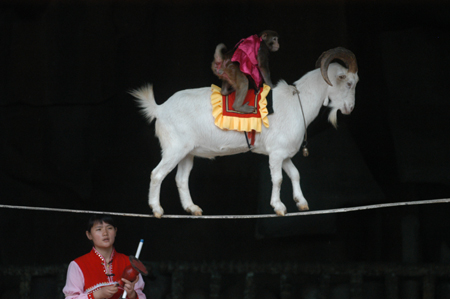Last night a reader named Andrew made a comment that I thought merited more attention than it might get as the fifteenth comment in a thread. He told the story of a goat to illustrate the idea that we can’t really think of abstractions except in terms of “concrete, observable phenomena that we have experienced with our five senses.” He wrote, “When I was a kid I had a pet goat that we mostly kept in a banyard, but ocassionally we would tether her to a stake to allow her fresh grazing areas elsewhere in the yard. One day I found that she had stretched her rope from the stake part-way around the base of a walnut tree, and was straining toward a clump of clover, just beyond reach. I saw that if she went back around the tree, then straight toward the clover, the rope would allow her to reach it easily. As it was her rope was making two sides of a triangle — if she took the hypotenuse, she could have the whole clump. So I tried to pull her away from the clover, to lead her back round the tree so she could reach it. This made no sense to her, of course, and she strained against me, her collar almost choking her. Only by grabbing her by the horns could I force her back around the tree. Then she could run straight for the clover and she began munching (with no sign of gratitude).
“I pictured this as a symbol of God’s leadership. It might sometimes appear that God is directing me away from what is good, even when he’s leading me toward what is best in the only way possible. With ignorance and short-sightedness, I might stubbornly strain against obedience, to my own detriment.
“So an abstract concept–God’s omniscience and loving guidance overcoming my sinfulness–was revealed to me by a concrete experience: a goat on a rope. Is it even possible to understand abstract truths that cannot be symbolized by the concrete? For me whenever I try to conceive of something abstract, in my mind it requires a concrete symbol.”
Andrew has a precedent in Flannery O’Connor. When it came to writing about writing, O’Connor was one of the very best. Here’s a long quotation from Mystery and Manners. This is from the piece entitled “The Nature and Aim of Fiction” (pp. 67-68). As Andrew observed in his story about the goat, there’s no good way for a fiction writer to get to the abstract except through the concrete.
The nature of fiction is in large measure determined by our perceptive apparatus. The beginning of human knowledge is through the senses, and the fiction writer begins where human perception begins. He appeals through the senses, and you cannot appeal to the senses through abstractions. It is a good deal easier for most people to state an abstract idea than to describe and thus re-create some object that they actually see. But the world of the fiction writer is full of matter, and this is what beginning fiction writers are loath to create. They are concerned primarily with unfleshed ideas and emotions…
The Manicheans separated spirit and matter. To them, all material things were evil. They sought pure spirit and tried to approach the infinite directly without any mediation of matter. This is also pretty much the modern spirit, and for the sensibility infected with it, fiction is hard if not impossible to write becuase fiction is so very much an incarnational art.
One of the most common and saddest spectacles is that of a person of really fine sensibility and acute psychological perception trying to write fiction by using these qualities alone. This type of writer will put down one intensely emotional or keenly perceptive sentence after the other, and the result will be complete dullness. The fact is that the materials of the fiction writer are the humblest. Fiction is about everything human and we are made out of dust, and if you scorn getting yourself dusty, then you shouldn’t try to write fiction. It’s not a grand enough job for you.










Canaan Bound
Just a couple of things that have come to mind regarding storytelling, fiction, symbolism, and abstractions:
1) The Bible is littered with stories, both real and fabricated, all written by man (but inspired by God) with the purpose of revealing a deeper, abstract truth about God.
2) Jesus of Nazareth taught in parables, which allowed his audience to reach an abstract truth through a concrete story.
(Ironic that I sometimes find the parables too abstract. Wish I didn’t have to do hours of research to understand the context.)
3) That’s really all I had to say. Other than the fact that I really do love symbolism, and I enjoy finding the deeper truths that stories reveal (whether it be in film or literature). The sentiments expressed in my comments on the previous post were perhaps misunderstood. I simply sought to express how my high school teachers robbed me of the opportunity to find meaning and arrive at conclusions on my own.
4) I really love that second goat on a rope picture. Thanks, JR.
Terri DeFoor
I need to go back and read some Mystery and Manners now that I’m trying my hand at fiction writing. I’m almost convinced I can’t do it. O’Connor nailed my problem in your quote, although I’m not sure I have that much “fine sensibility and acute psychological awareness.” Sometimes I like the sentences I craft, but when I string them together the result is “complete dullness.” I need to get dusty or go back to writing essays. And who’s going to read those now that I don’t have any professors?
Jonathan Rogers
Terri, you really should pick up Mystery and Manners if you’re trying your hand at fiction. Or FO’s letters, collected as The Habit of Being. There’s something very reassuring about the way she talks about writing. You think, “OK…maybe I can do this.” Which is to say, FO reminds you that good writing doesn’t require brilliance so much as the ability to pay attention to the world around you. Brilliance helps, no doubt, and FO had plenty of it, but it’s not the most important tool in her tool belt.
The fact that she talks like all your relatives doesn’t hurt either.
Terri DeFoor
Thanks, Jonathan. I’ve read some of both of the books you mentioned, but it’s been a while. I have pulled them off the shelf to re-read for some encouragement and inspiration. And a heapin’ helpin’ of southern candor.
Patrick
So, concrete is good for filling in abstract holes. 😉
Andrew
Thanks for elevating the status of my goat post. The picture of a monkey riding a goat across a tightrope is inspirational and represents a high point in the history of domestication.
I was reading about the “five senses” (on wikipedia) and found that more recent classifications enumerate between nine and twenty senses (including balance, awareness of limb location, awareness of acceleration, etc). This might have some relevance for writers checking off their list of five. I also learned that the “tongue map” of taste sensitivities we learned in kindergarten is inaccurate.
Canaan Bound
“When I was a KID I had a pet goat…” Just noticed the humor in this line.